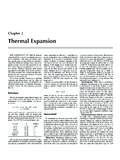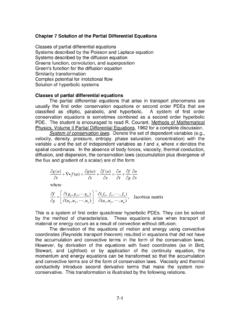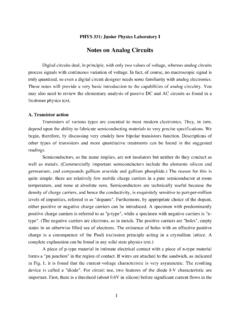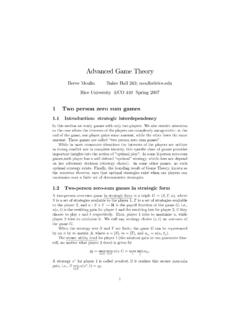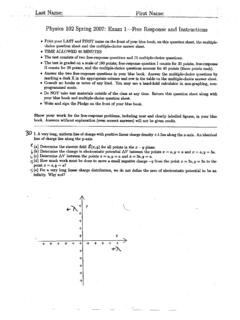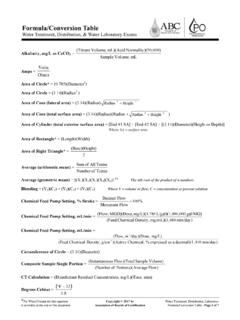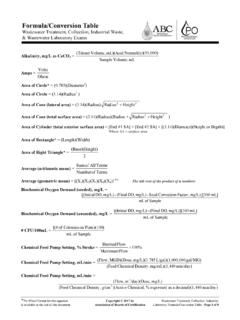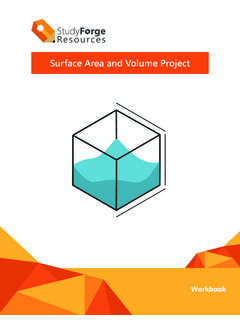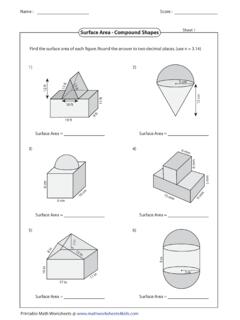Transcription of Surface Area - Rice University
1 Surface area The specific Surface area is a dominant parameter in models for permeability and in the transport of a species that can adsorb on the mineral surfaces . The specific Surface area is usually expressed as square meters of Surface per gram of solid. Here we will factor out the grain density and express the specific Surface area as square meters per cubic centimeter of solid. (Later we will express the specific Surface as a ratio of pore Surface /pore volume.) The solid will be modeled as an oblate spheroid.
2 This is a solid of revolution of an ellipse about its minor axis. The minor radius is b and the major radius is a. The ratio, Sb/V, is given by the following formula. (Mensuration formulas) 23311log241eSbV + =+ where the eccentricity is 22aba = The group, (Sb/V), will have consistent units if S is in square meters, V is in cubic centimeters, and b is in microns. Figure plots the specific Surface as a function of the minor radius, b.
3 The grain density ( gm/cm3 for quartz) has been factored out and the specific Surface area is expressed as per unit cm3 rather than gram. A upper coarse sand grain has a radius of about 103 microns Fig. Parameters of an ellipse (CRC Standard Mathematical Tables, 1987) Fig Surface to volume ratio of oblate spheroid 3- 26(one millimeter) and it has a Surface area of about 10-3 m2 /cm3. A silt or clay particle with a minor radius of about micron has a Surface area of about m2/cm3. A smectite sheet with a thickness of about 10-3 micron ( nm) will have a Surface area of about 103 m2/cm3.
4 (Note: Is something is wrong here? The sphere appears to have a greater specific area than an oblate spheroid. A sphere should be a body of minimum area for a given volume. Answer: For the same volume, an oblate spheroid will have its Surface to volume ratio increasing in proportion to the 2/3 power of the aspect ratio. The specific Surface is plotted as a function of the radius of the minor axis. The major axis is greater than the minor axis ratio by the aspect ratio.) Clay type area , m2/gram kaolinite 45 illite 175 montmorillonite 800 When evaluating adsorption, the specific Surface area of sand grains usually is not of much interest compared to the clays contained in the rock.
5 For example the following table illustrates the range of specific areas that can be expected from clays (Corey 1990) In addition to the importance of the Surface /volume ratio to adsorption on porous media, the ratio of Surface area to pore volume will be shown later to be an important parameter in models of permeability and NMR relaxation of fluids in the pore space. The expression for the specific Surface shows the Surface to pore volume ratio to be inversely proportional to the length of the minor axis, b, for a given eccentricity.
6 The constant of proportionality is 3 for a sphere and is equal to 3/2 for a thin disk. (Note: I think it should be 2 for a thin disk.) Porosity Porosity is the fraction (or percent) of the rock bulk volume occupied by pore space. The porosity may be divided into macro porosity and micro porosity in rocks that have a bimodal pore size distribution. Some examples include: (1) sandstones with a significant amount of clays, (2) sandstones with microporous chert grains, , interparticle and intraparticle porosity, (3) carbonate rocks with vuggy porosity (caverns are an extreme case) and matrix porosity, (4) carbonate rocks with moldic porosity and matrix porosity, (5) carbonate rocks with interparticle porosity and intercrystalline porosity, (6) fracture porosity and matrix porosity.
7 The total porosity can also be divided into effective porosity and ineffective porosity. Ineffective pores are pores with no openings or zero coordination number. Effective porosity can be divided into Cul-de-sac or dead-end pores with a coordination number of one and catenary pores with coordination number of two or more. These types of porosity are illustrated in Fig. 3- 27 Fig. The three basic types of porosity. (Selley 1985) Sandstones The rules for the factors governing the magnitude of the porosity is different for clastic (sandstone) and carbonate rocks.
8 The following relationships between porosity and textural properties apply for sandstones (Jorden and Campbell 1984). Also see Fig. 1. Porosity is independent of grain size for the same sorting. 2. Porosity decreases as sorting becomes poorer. See Fig. and 3. Porosity increases as grain sphericity (shape) decreases and as grain angularity (roundness) decreases. The general, though not universal, tendency is for diagenesis to reduce original porosity of clastic rocks.
9 The alteration of porosity through diagenesis is illustrated in Fig. The porosity of the original sediment may originally be 40%-50%. In regions of rapid sedimentation such as in a river delta, compaction is the primary diagenetic alteration mechanism. Subsidence may accompany the compaction. Dissolution of some minerals and precipitation can result in consolidation of the rock and reduction of porosity by the process of cementation. Fig. Effect of sorting on porosity (Bear 1972) 3- 28 Fig.
10 Diagenetic pathways of sandstones (Selley, 1985) Carbonate rocks At deposition, carbonate sediments are highly to very highly porous. Some sediments have porosity ranging from to at deposition. The following relationships between porosity and textural properties apply to carbonates (Jorden and Campbell 1984). 1. Porosity is not correlated strongly with either median grain size or sorting. 2. Porosity is controlled largely by the amount of fines present , the larger the precent fines, the larger the porosity. 3. Diagenesis of carbonate rocks can result in porosity that is either significantly less or greater than original porosity.
